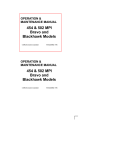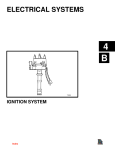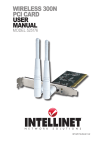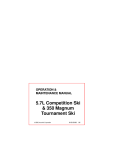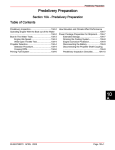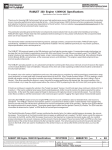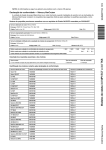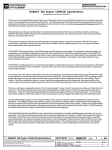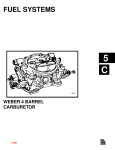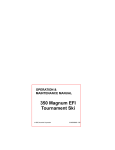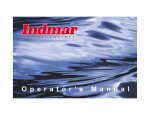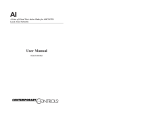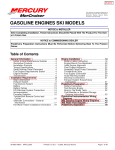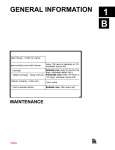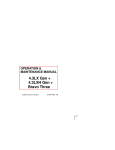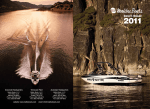Download Maintenance
Transcript
IMPORTANT INFORMATION MAINTENANCE Index 1 B Table of Contents Page Maintenance Schedules . . . . . . . . . . . . . . . . . . . 1B-1 Maintenance Intervals . . . . . . . . . . . . . . . . . . 1B-1 Alpha Models . . . . . . . . . . . . . . . . . . . . . . . . . 1B-1 Bravo Models . . . . . . . . . . . . . . . . . . . . . . . . . 1B-4 Tune-Up Specifications . . . . . . . . . . . . . . . . . . . 1B-7 Fluid Capacities . . . . . . . . . . . . . . . . . . . . . . . . . . 1B-9 20-Hour Break-In Period . . . . . . . . . . . . . . . 1B-10 Fuel, Oil, Fluid, and Coolant Specifications . 1B-10 Fuel . . . . . . . . . . . . . . . . . . . . . . . . . . . . . . . . 1B-10 Crankcase Oil . . . . . . . . . . . . . . . . . . . . . . . . 1B-12 Power Steering Fluid . . . . . . . . . . . . . . . . . . 1B-13 Coolant for Closed Cooling System . . . . . 1B-13 Maintaining Crankcase Oil Level . . . . . . . . . . 1B-13 Overfilled Engine Crankcase . . . . . . . . . . . 1B-13 Checking Engine Oil Level/Filling . . . . . . . 1B-13 Changing Oil and Filter . . . . . . . . . . . . . . . . . . . 1B-14 Maintaining Power Steering Pump Fluid Level . . . . . . . . . . . . . . . . . . . . . . . . . . . . . 1B-14 With Engine Warm . . . . . . . . . . . . . . . . . . . . 1B-14 With Engine Cold . . . . . . . . . . . . . . . . . . . . . 1B-15 Filling and Bleeding Power Steering System 1B-15 Maintaining Closed Cooling Coolant Level . . 1B-16 Flushing Cooling System . . . . . . . . . . . . . . . . . 1B-16 Lubrication . . . . . . . . . . . . . . . . . . . . . . . . . . . . . 1B-18 Throttle Cable . . . . . . . . . . . . . . . . . . . . . . . . 1B-18 Shift Cable . . . . . . . . . . . . . . . . . . . . . . . . . . . 1B-19 Engine Coupler/U-Joint Shaft Splines . . . 1B-19 Audio Warning System . . . . . . . . . . . . . . . . . . . 1B-20 Maintenance . . . . . . . . . . . . . . . . . . . . . . . . . 1B-20 Cold Weather or Extended Storage . . . . . . . . 1B-20 Precautions . . . . . . . . . . . . . . . . . . . . . . . . . . 1B-20 Layup . . . . . . . . . . . . . . . . . . . . . . . . . . . . . . . 1B-21 Draining Instructions . . . . . . . . . . . . . . . . . . . . . 1B-22 Draining Seawater (Raw-Water) Cooled Models . . . . . . . . . . . . . . . . . . . . . . 1B-22 Draining Seawater Section of Closed Cooled (Coolant) Models . . . . . . . . . . . . . . 1B-25 Recommissioning . . . . . . . . . . . . . . . . . . . . . 1B-27 Index 1B-0 - MAINTENANCE 90-823226--1 996 Maintenance Schedules Maintenance Intervals Maintenance intervals and the tasks to be performed, as shown in this current schedule, or as found in a previously printed schedules, are generally based on an average boating application and environment. However, individual operating habits and personal maintenance preferences can have an impact on the suggested intervals. In consideration of these factors, MerCruiser has adjusted some maintenance intervals and corresponding tasks to be performed. In some cases, this may allow for more individual tasks to be performed in a single visit to the serving dealer, rather than multiple visits. Therefore, it is very important that the boat owner and servicing dealer discuss the current Maintenance Schedule and develop appropriate maintenance intervals to coincide with the individual operating habits, environment, and maintenance requirements. Alpha Models SCHEDULED MAINTENANCE THAT CAN BE PERFORMED BY OWNER/OPERATOR NOTE: Only perform maintenance which applies to your particular power package. Task Interval Engine Crankcase Oil - Check level Closed Cooling Coolant - Check level Power Steering Fluid - Check level Stern Drive Unit Oil - Check level Battery - Check level and inspect for damage W kl Weekly Fuel Pump Sight Tube (If so Equipped) - Check that no fuel is present Power Trim Pump Oil - Check level Anodes - Inspect for erosion Gear Housing Water Pickups - Check for marine growth or debris Drive Belt(s) - Inspect condition and check tension Every 100 hours of operation or 120 days. Whichever occurs first. Saltwater Use: Every 50 hours of operation or 60 days Whichever occurs first. days, first Power Package - Exterior Surfaces - Spray with rust Freshwater Use: Every 100 hours of operation or preventative 120 days, Whichever occurs first. Propeller Shaft - Lubricate Power Package Exterior Surfaces - Clean and paint Once a year Cooling System - Flush seawater section Saltwater Use: After every use. Index 90-823226--1 996 MAINTENANCE - 1B-1 SCHEDULED MAINTENANCE THAT CAN BE PERFORMED BY DEALER NOTE: Only perform maintenance which applies to your particular power package. Task Seawater Pickup Pump - Disassemble and inspect Interval Whenever insufficient seawater flow is suspected. (If operating temperature exceeds normal range.) Crankcase Oil and Filter Change Ignition system - Clean and Inspect condition. Flame Arrestor and Crankcase Ventilation Hose Clean and Inspect. Positive Crankcase Ventilation (PCV) Valve (If Equipped) - Change Stern Drive unit Oil - Change Gimbal Ring Clamping Screws Retorque to 50-55 ft. lb. (67-74 N·m) Rear Engine Mounts Check torque to 30-40 ft. lb. (47-54 N·m) Gimbal Bearing - Lubricate Cooling System - Clean and Inspect Steering System - Lubricate and inspect for loose, End E d off fifirst b boating i season and d thereafter, h f every 100 damage or missing parts. hours of operation or once yearly, whichever occurs first Electrical System - Check for loose or damaged first. wiring. Closed Cooling System Pressure Cap - Clean, inspect and test . Cooling System Hoses and Clamps - Inspect for damage and deterioration. Check clamps for tightness. Continuity Circuit - Check components for loose connections, broken or frayed wires. Shift and Throttle Cable and Linkage - Lubricate and inspect for loose, damaged or missing parts. Engine Exhaust System - Inspect externally for damage, deterioration and restrictions. Check for tightness. Ignition System - Check Timing and adjust as needed. Index 1B-2 - MAINTENANCE 90-823226--1 996 SCHEDULED MAINTENANCE THAT CAN BE PERFORMED BY DEALER (CONTINUED) NOTE: Only perform maintenance which applies to your particular power package. Task Interval Steering Head and Remote Control - Inspect and End of first boating season and thereafter, every 100 lubricate. hours of operation or once yearly, yearly whichever occurs Carburetor (If Equipped) - Inspect and adjust. first. Throttle Body (EFI Models) - Inspect. Fuel Filters - Replace. Quicksilver Mercathode System - Test output. Closed Cooling Coolant - Test for Alkalinity Once a Year O Y Heat Exchanger - Clean seawater section. Drive Unit Bellows and Clamps - Inspect. Engine Alignment - Check. End of first boating season and thereafter, Saltwater Use: Every 300 hours of operation or once Engine Coupling Universal Joint Shaft Splines yearly, whichever occurs first Lubricate. Freshwater Use: Every 300 hours of operation or Universal Joint Cross Bearings- Inspect. once every two years, whichever occurs first. Closed Cooling Coolant - Replace. Every Two Years Index 90-823226--1 996 MAINTENANCE - 1B-3 Bravo Models SCHEDULED MAINTENANCE THAT CAN BE PERFORMED BY OWNER/OPERATOR NOTE: Only perform maintenance which applies to your particular power package. Task Interval Engine Crankcase Oil - Check level Closed Cooling Coolant - Check level Power Steering Fluid - Check level Stern Drive Unit Oil - Check level Battery - Check level and inspect for damage W kl Weekly Fuel Pump Sight Tube (If so Equipped) - Check that no fuel is present Power Trim Pump Oil - Check level Anodes - Inspect for erosion Gear Housing Water Pickups - Check for marine growth or debris Drive Belt(s) - Inspect condition and check tension Every 100 hours of operation or 120 days. Whichever occurs first. Saltwater Use: Every 50 hours of operation or 60 days, Whichever occurs first. Power Package - Exterior Surfaces - Spray with rust Freshwater Use: Every 100 hours of operation or preventative 120 days, Whichever occurs first. Propeller Shaft - Lubricate Power Package Exterior Surfaces - Clean and paint Once a year Cooling System - Flush seawater section Saltwater Use: After every use. Index 1B-4 - MAINTENANCE 90-823226--1 996 SCHEDULED MAINTENANCE THAT SHOULD BE PERFORMEDBY A DEALER (CONTINUED) NOTE: Only perform maintenance which applies to your particular power package. Task Seawater Pickup Pump - Disassemble and inspect Interval Whenever insufficient seawater flow is suspected. (If operating temperature exceeds normal range.) Crankcase Oil and Filter Change Ignition system - Clean and Inspect condition. Flame Arrestor and Crankcase Ventilation Hose Clean and Inspect. Positive Crankcase Ventilation (PCV) Valve (If So Equipped) - Change Stern Drive unit Oil - Change Gimbal Ring Clamping Screws - Retorque to 40 ft. lb. (54 N·m) Rear Engine Mounts - Check torque to 30-40 ft. lb. (47-54 N·m) Gimbal Bearing - Lubricate Cooling System - Clean and Inspect Engine Alignment - Check Engine Coupling Universal Joint Shaft Splines Lubricate Steering System - Lubricate and inspect for loose, damage or missing parts. End E d off first fi boating b i season and d thereafter, h f every 100 hours of operation or once yearly, yearly whichever occurs first. Electrical System - Check for loose or damaged wiring. Cooling System Hoses and Clamps - Inspect for damage and deterioration. Check Clamps for tightness. Closed Cooling System Pressure Cap - Clean, inspect and test . Continuity Circuit - Check components for loose connections, broken or frayed wires. Shift and Throttle Cable and Linkage - Lubricate and inspect for loose, damaged or missing parts Engine Exhaust System - Inspect externally for damage, deterioration and restrictions. Check for tightness. Ignition System - Check Timing and adjust as needed. Index 90-823226--1 996 MAINTENANCE - 1B-5 SCHEDULED MAINTENANCE THAT SHOULD BE PERFORMEDBY A DEALER (CONTINUED) NOTE: Only perform maintenance which applies to your particular power package. Task Steering Head and Remote Control - Inspect and Lubricate. Carburetor (If Equipped) - Inspect and adjust. Interval End of first boating season and thereafter, every 100 hours of operation or once yearly, yearly whichever occurs first. Throttle Body (EFI Models) - Inspect Fuel Filters - Replace Quicksilver Mercathode System - Test output. Closed Cooling Coolant - Test for Alkalinity O Once a Year Y Heat Exchanger - Clean seawater section. Drive Unit Bellows and Clamps - Inspect Universal Joint Cross Bearings- Inspect Closed Cooling Coolant - Replace End of first boating season and thereafter, every 200 hours of operation or once yearly, whichever occurs first. Every Two Years Index 1B-6 - MAINTENANCE 90-823226--1 996 Tune-Up Specifications MODEL Propshaft Horsepower Ratings (Kilowatts) 1 Number Of Cylinders MCM 4.3 LX 155 (115) 175 (130) 6 Displacement 262 Cu. In. (4.3L) Bore/Stroke 4.00/3.48 (101.6/88.4 mm) Compression Ratio 9.3:1 Compression Pressure Idle RPM In Neutral MCM 4.3L 180 PSI (1241 kPa) 2 650-700 Max RPM (at W.O.T.) 4400-4800 Oil Pressure (at 2000 RPM) 30-55 PSI (207-379 kPa) Min. Oil Pressure 4 PSI (28 kPa) Fuel Pump Pressure 3-7 PSI (21-48 kPa) Electrical System 12 Volt Negative (–) Ground Min. Battery Cold Cranking Amperes 375 cca/475 mca/90 Ah Firing Order 1-6-5-4-3-2 Spark Plug Type AC-MR43T / Champion RV15YC4 / NGK BR6FS Spark Plug Gap Timing Thunderbolt IV Models .040 In. (1 mm) 3 8° BTDC Thunderbolt V Models 3 10° BTDC Preliminary Idle Mixture 1-1/4 Turn Thermostat 1 2 143° F (62° C) Power Rated in Accordance with NMMA (National Marine Manufacturers’ Association) rating procedures. Measured using an accurate service tachometer and fuel injection engine at operating temperature. 3 Timing must be set using a special procedure as outlined in the appropriate Service Manual. Timing cannot be properly set using the conventional method. Index 90-823226--1 996 MAINTENANCE - 1B-7 Tune-Up Specifications MODEL Propshaft Ratings HP.(KW)1 MCM 4.3LX GEN + ALPHA AND BRAVO (2 BBL) MCM 4.3LXH GEN + ALPHA AND BRAVO (4 BBL) MCM 262 MAGNUM EFI GEN + ALPHA AND BRAVO 190 (142) 205 (153) 205 (153) Displacement Bore/Stroke In. (mm) 262 CID (4.3L) 4.00 x 3.48 (101.6 x 88.4) Compression Ratio 9.4:1 Compression Pressure Idle RPM In Neutral 2 180 PSI (1241 kPa) 650 600 Maximum RPM (at W.O.T.) 4400-4800 Oil Pressure (at 2000 RPM) 30-55 PSI (207-379 kPa) Minimum Oil Pressure (at Idle) 4 PSI (28 kPa) Fuel Pump Pressure Fuel Pressure (Running) (E.F.I. Only) 3-7 PSI (21-48 kPa) Does Not Apply 30 PSI (207 kPa) Electrical System 12 V Negative (–) Ground Minimum Battery Requirements 550 cca / 700 mca / 120 Ah Firing Order 1-6-5-4-3-2 AC - MR43LTS Champion RS12YC NGK BPR6EFS .045 (1.1 mm) Spark Plug Type Spark Plug Gap Timing (at Idle RPM)3 10° BTDC 8° BTDC Preliminary Idle Mixture 1-1/4 Turns Does Not Apply Thermostat 1 2 160° F (71° C) Power Rated in Accordance with NMMA (National Marine Manufacturers’ Association) rating procedures. Measured using an accurate service tachometer and fuel injection engine at operating temperature. 3 Timing must be set using a special procedure as outlined in the appropriate Service Manual. Timing cannot be properly set using the conventional method. Index 1B-8 - MAINTENANCE Firing Order 1-6-5-4-3-2 72976 90-823226--1 996 Fluid Capacities NOTICE All capacities are approximate fluid measures. MCM (Stern Drive) Model All Models Crankcase Oil1 (with filter) Seawater Cooling 4-1/2 U.S. Qts. (4.3 L) System2 15 U.S. Qts. (14.1 L) Closed Cooling System 1Always Use Dipstick to Determine Exact Quantity of Oil Required 2Seawater Cooling System Capacity Information is for Winterization 20 U.S. Qts. (19 L) Use Only Index 90-823226--1 996 MAINTENANCE - 1B-9 20-Hour Break-In Period IMPORTANT: The first 20 hours of operation is the engine break-in period. Correct break-in is essential to obtain minimum oil consumption and maximum engine performance. During this break-in period, the following rules must be observed: • Do not operate below 1500 RPM for extended periods of time for first 10 hours. Shift into gear as soon as possible after starting and advance throttle above 1500 RPM if conditions permit safe operation. • Do not operate at one speed consistently for extended periods. • Do not exceed 3/4 throttle during first 10 hours. During next 10 hours, occasional operation at full throttle is permissible (5 minutes at a time maximum). • Avoid full throttle acceleration from idle speed. • Do not operate at full throttle until engine reaches normal operating temperature. • Frequently check crankcase oil level. Add oil if needed. It is normal for oil consumption to be high during break-in period. • After 20-hour break-in period, drain crankcase oil and replace oil filter (see “Maintenance”). Fill crankcase with correct oil (see “Specifications”). Fuel, Oil, Fluid, and Coolant Specifications Fuel ! CAUTION Use of improper gasoline can damage the engine seriously. Engine damage that results from use of improper gasoline is considered misuse of the engine and is not covered under MerCruiser Warranty. USA and Canada Fuel having a posted pump Octane Rating of 87(R + M)/2 minimum. Premium gasoline [92 (R + M)/2] is also acceptable. DO NOT use leaded gasoline. Outside USA and Canada Fuel having a posted pump Octane Rating of 92 RON minimum. Premium gasoline (98 RON) is also acceptance. If unleaded is not available, use a major brand of leaded gasoline. Gasolines containing alcohol, either methyl alcohol (methanol) or ethyl alcohol (ethanol) may cause increased: • Corrosion of metal parts. • Deterioration of elastomer and plastic parts. • Fuel permeation through flexible fuel lines. • Wear and damage of internal engine parts. • Starting and operating difficulties. Some of these adverse effects are due to the tendency of gasolines containing alcohol to absorb moisture from the air, resulting in a phase of water and alcohol separating from the gasoline in the fuel tank. The adverse effects of alcohol are more severe with methyl alcohol (methanol) and are worse with increasing alcohol content. Index 1B-10 - MAINTENANCE 90-823226--1 996 ! WARNING Fire and Explosion Hazard: Fuel leakage from any part of the fuel system can be a fire and explosion hazard which can cause serious bodily injury or death. Careful periodic inspection of the entire fuel system is mandatory, particularly after storage. All fuel system components including fuel tanks (whether plastic, metal or fiberglass), fuel lines, primer bulbs, fittings, fuel filters and carburetors should be inspected for leakage, softening, hardening, swelling or corrosion. Any sign of leakage or deterioration requires replacement before further engine operation. Because of possible adverse effects of alcohol in gasoline, it is recommended that only alcohol-free gasoline be used where possible. If only fuel containing alcohol is available, or if the presence of alcohol is unknown, increased inspection frequency for leaks and abnormalities is required. ! WARNING Avoid gasoline fire or explosion. Improper installation of brass fittings or plugs into fuel pump or fuel filter base can crack casting and/or cause a fuel leak. IMPORTANT: When operating a MerCruiser engine on gasoline containing alcohol, storage of gasoline in the fuel tank for long periods should be avoided. Long periods of storage, common to boats, create unique problems. In cars, alcohol-blend fuels normally are consumed before they can absorb enough moisture to cause trouble, but boats often sit idle long enough for phase separation to take place. In addition, internal corrosion may take place during storage if alcohol has washed protective oil films from internal components. NO LEAD GASOLINE U.S. Environmental Protection Agency (EPA) and Canadian government regulations require the removal of lead (anti-knock compound) from all gasoline because lead emission in exhaust is a health hazard. In order to maintain octane ratings, many gasoline manufacturers are adding ethyl alcohol (ethanol) or methyl alcohol (methanol) to the gasoline to replace the lead. The use of any good grade unleaded regular or premium gasolines with a minimum posted octane rating [(A.K.I.) Anti-Knock Index] of 87, are satisfactory for use in your engine. In areas where unleaded regular or premium gasolines are not available, a good grade leaded regular with a minimum posted octane rating (A.K.I.) of 89 may be used. GASOLINE/ALCOHOL BLENDS Many new motor vehicle owner manuals are warning about the potential damage from using gasoline containing alcohol, especially METHANOL. They cite possible fuel system damage and performance problems. These are just two of the hazards that may be caused by alcohol. These same problems as well as the additional safety risk of fire and explosion from fuel system leaks apply to marine inboard engines. METHANOL is more severe in its bad effect than is ETHANOL. Alcohol is also more severe in older engines since newer engines have materials which are more resistant to alcohol. EFFECTS OF GASOLINE/ALCOHOL BLENDS ON MARINE ENGINES Corrosion of metals may result from use of alcohol-gasoline blends. Portable or permanently installed fuel tanks of metal or fiberglass, fuel filters, fuel lines and float bowls may be affected by alcohol blended fuels. Many fiberglass fuel tanks are slowly dissolved by alcohol, leading immediately to filter and carburetor plugging and eventually to tank failure. Index 90-823226--1 996 MAINTENANCE - 1B-11 Fuels containing alcohol will absorb moisture from the air. At first, this moisture will remain in solution, but once the water content of the fuel has built up to about one-half of one percent, it will separate out (phase separation), bringing the alcohol with it. This alcohol-water mixture settles to the bottom of the fuel tank and if this mixture gets into the engine, the engine can be seriously damaged internally, as it may wash the protective film of oil off the bore of any cylinder that it enters. Before the engine can be restarted, it is necessary to remove the separated alcohol and water layer, flush out the fuel system with clean fuel and remove and dry the spark plugs. BOAT/MOTOR STORAGE We have recommended pump posting of alcohol content of gasoline. Further we recommend using gasoline known not to contain any METHANOL or ETHANOL when possible. TEST FOR ALCOHOL CONTENT IN GASOLINE The following is an acceptable and widely used field procedure for the detection of alcohol in gasoline. Use any small transparent bottle or tube that can be capped and is, or can be, provided with graduations or a mark at about 1/3 full. A pencil mark on a piece of adhesive tape may be used. Procedure 1. Fill the container with water to the mark. When operating a MerCruiser engine on gasoline containing alcohol, storage of gasoline in the fuel tank for long periods of time should be avoided. Long periods of storage, common to boats, create unique problems. In cars, gasoline/alcohol blend fuels normally are consumed before they can absorb enough moisture to cause trouble, but boats often sit idle long enough for phase separation to take place. In addition, internal corrosion may take place during storage if alcohol has washed protective oil films from internal components. WINTER STORAGE 2. Add fuel almost to fill the container, leaving some air space, then cap the container. The proportions of fuel to water are not critical, but there should be 2 to 3 times as much fuel as water. 3. Shake container vigorously and allow it to sit upright for 3 to 5 minutes. If the volume of water appears to have increased, alcohol is present. If you are not sure, there is no need for concern. If the dividing line between water and fuel becomes cloudy, use the middle of the cloudy band. Crankcase Oil If boat is to be placed in winter storage, carburetors must be run dry at idle RPM. Permanent fuel tanks should be drained completely and Quicksilver Gasoline Stabilizer and Conditioner added to any fuel remaining in the tank. Portable fuel tanks should be emptied completely. To help obtain optimum engine performance and to provide maximum protection, we strongly recommend the use of Quicksilver 4-Cycle Marine Engine Oil. If not available, a good grade, straight weight, detergent automotive oil of correct viscosity, with an API classification of SF or SG, may be used. WARRANTY The following chart is a guide to crankcase oil selection. Oil filter should always be changed with oil. Performance problems and fuel system or other damage resulting from the use of gasoline-alcohol blended fuels are not the responsibility of MerCruiser and will not be covered under our warranty. In those areas where recommended straight weight oil is not available, a multi-viscosity 20W-40 (SF or SG) or, as a second but less preferable choice, 20W-50 (SF or SG) may be used. CONTINUING EVALUATIONS The effects of gasoline with ETHANOL and METHANOL are still being evaluated by the United States Coast Guard, the National Marine Manufacturers Association (NMMA), Mercury Marine and other engine and boat manufacturers. Index 1B-12 - MAINTENANCE 90-823226--1 996 IMPORTANT: The use of non-detergent oils, multi-viscosity oils (other than 20W-40 or 20W-50), low quality oils or oils which contain solid additives specifically are not recommended. SAE 40W SH or CF/CF-2 SAE 30W SH or CF/CF-2 SAE 20W SH or CF/CF-2 72010 Power Steering Fluid Use Quicksilver Power Trim and Steering Fluid, or automatic transmission Fluid (ATF), Dexron, Dexron II or Dexron III. Coolant for Closed Cooling System ! CAUTION Alcohol or Methanol base antifreeze or plain water, are not recommended for use in fresh water section of cooling system at any time. We recommend that the coolant section of closed cooling system be filled with Quicksilver Pre-Mixed Engine Coolant. In areas where the possibility of freezing does not exist, it is permissible to use a solution of rust inhibitor and water (mixed to manufacturer’s recommendations). MerCruiser V-6 engines can use any type of permanent antifreeze or any brand antifreeze solution that meets GM specification 1825M. Maintaining Crankcase Oil Level Overfilled Engine Crankcase Overfilled crankcases (oil level being too high ) can cause a fluctuation or drop in oil pressure and rocker arm “clatter” on MerCruiser engines. The over-full condition results in the engine crankshaft splashing and agitating the oil, causing it to foam (become aerated). The aerated oil causes the hydraulic valve lifters to “bleed down.” This, in turn, results in rocker arm “clatter” and loss of engine performance, due to the valves not opening properly. Care must be taken when checking engine oil level. Oil level must be maintained between the ADD mark and the FULL mark on the dipstick. To ensure that you are not getting a “false reading,” make sure the following steps are done before checking the oil level. • Boat “at rest” in the water, or • If boat is on a trailer, raise or lower bow until the boat is setting at the approximate angle that it would be if setting “at rest” in the water. • Allow sufficient time for oil to drain into the crankcase if engine has just been run or oil has just been added. Checking Engine Oil Level/Filling IMPORTANT: ENGINE CRANKCASE OIL MUST BE CHECKED AT INTERVALS SPECIFIED IN “MAINTENANCE SCHEDULE” CHART. It is normal for an engine to use a certain amount of oil in the process of lubrication and cooling of the engine. The amount of oil consumption is greatly dependent upon engine speed, with consumption being highest at wide-open-throttle and decreasing substantially as engine speed is reduced. Index 90-823226--1 996 MAINTENANCE - 1B-13 1. Stop engine and allow boat to come to a rest. 2. Allow oil to drain back into oil pan - approximately 5 minutes. 3. Remove dipstick. Wipe clean and reinstall. Push dipstick all the way into dipstick tube. 4. Remove dipstick and note the oil level. 5. Oil level must be between the FULL and ADD marks. 6. If oil level is below ADD mark, proceed to Steps 7 and 8. Maintaining Power Steering Pump Fluid Level With Engine Warm 1. Stop engine and position drive unit so that it is straight back. 2. Remove fill cap/dipstick from power steering pump and note fluid level. b a 7. Remove oil filler cap from valve rocker arm cover. 8. Add required amount of oil to bring level up to, but not over, the FULL mark on dipstick. Changing Oil and Filter 1. Start engine and run until it reaches normal operating temperatures. IMPORTANT: Change oil when engine is warm from operation, as it flows more freely, carrying away more impurities. 72517 2. Stop engine. 3. Remove drain plug from oil pan or from oil drain hose. NOTE: If drain plug is not accessible because of boat construction, oil may be removed through dipstick tube, using a Quicksilver Crankcase Oil Pump. 4. After oil has drained completely, reinstall drain plug (if removed) and tighten securely. a - Fill Cap / Dipstick b - Power Steering Pump 3. Level should be between the FULL HOT mark and ADD mark on dipstick. 5. Remove and discard oil filter and its sealing ring. 6. Coat sealing ring on new filter with engine oil, and install. Tighten filter securely (following filter manufacturer’s instructions). Do not over-tighten. 7. Fill crankcase with oil. 8. Start engine and check for leaks. a 72518 a - Proper Fluid Level With Engine Warm Index 1B-14 - MAINTENANCE 90-823226--1 996 4. If level is below ADD mark, but fluid is still visible in pump reservoir, add required amount of Quicksilver Power Trim and Steering Fluid or automatic transmission fluid (ATF), Dexron, or Dexron II, through fill cap opening, to bring level up to FULL HOT mark on dipstick. DO NOT OVERFILL. 5. If fluid is not visible in reservoir, a leak exists in the power steering system. Find cause and correct. With Engine Cold 1. With engine stopped, position drive unit so that it is straight back. Remove fill cap/dipstick from power steering pump. Add Quicksilver Power Trim and Steering Fluid or automatic transmission fluid (ATF), Dexron, Dexron II, or Dexron III as required, to bring level up to FULL COLD mark on dipstick. IMPORTANT: Use only Quicksilver Power Trim and Steering Fluid or automatic transmission fluid (ATF), Dexron, Dexron II and Dexron III in power steering system. 1. With engine stopped, position drive unit so that it is straight back. 2. Turn steering wheel back and forth to end of travel in each direction several times, then recheck fluid level and add fluid, if necessary. 2. Remove fill cap/dipstick from power steering pump and note fluid level. 3. Install vented fill cap. 3. Level should be between FULL COLD mark and bottom of dipstick. a 72519 a - Proper Fluid Level With Engine Cold 4. If level is below bottom of dipstick, but fluid is still visible in pump reservoir, add required amount of Quicksilver Power Trim and Steering Fluid or automatic transmission fluid (ATF), Dexron, Dexron II, or Dexron III through fill cap opening, to bring level up to FULL COLD mark on dipstick. DO NOT OVERFILL. If fluid is not visible in reservoir, a leak exists in the power steering system. Find cause and correct. ! CAUTION DO NOT operate engine without water being supplied to seawater pickup pump, or pump impeller may be damaged and subsequent overheating damage to engine may result. 4. Start engine and run at fast idle (1000-1500 RPM) until engine reaches normal operating temperature. During this time, turn steering wheel back and forth to end of travel in each direction several times. 5. Position drive unit so that it is straight back and stop engine. Remove fill cap from pump. Allow any foam in pump reservoir to disperse, then check fluid level and add fluid, as required, to bring level up to FULL HOT mark on dipstick. DO NOT OVERFILL. Reinstall fill cap securely. IMPORTANT: Drive unit must be positioned straight back and power steering fluid must be hot to accurately check fluid level. 6. If fluid is still foamy (in Step 5), repeat Steps 4 and 5 until fluid does not foam and level remains constant. Filling and Bleeding Power Steering System IMPORTANT: Power steering system must be filled exactly as explained in the following to be sure that all air is bled from the system. All air must be removed, or fluid in pump may foam during operation and be discharged from pump reservoir. Foamy fluid also may cause power steering system to become spongy, which may result in poor boat control. Index 90-823226--1 996 MAINTENANCE - 1B-15 Maintaining Closed Cooling Coolant Level ! WARNING Allow engine to cool down before removing pressure cap. Sudden loss of pressure could cause hot coolant to boil and discharge violently. After engine has cooled, turn cap 1/4 turn to allow any pressure to escape slowly, then push down and turn cap all the way off. 1. Coolant level in heat exchanger should be full (to bottom of filler neck). IMPORTANT: When reinstalling pressure cap, be sure to tighten it until it contacts stop on filler neck. 2. Coolant level should be between the ADD and FULL marks on coolant recovery reservoir with the engine at normal operating temperature. Flushing Cooling System If engine is operated in salty, polluted, or mineral-laden water, flush cooling system (preferably after each use) to reduce corrosion and prevent the accumulation of deposits in the system. Thoroughly flush cooling system prior to storage. ! WARNING When flushing cooling system with boat out of the water, be certain that area in vicinity of propeller is clear and that no person is standing nearby. As a precautionary measure, it is recommended that propeller be removed. ! CAUTION To prevent engine or stern drive unit damage DO NOT run engine or drive unit without water being supplied to water intake openings on gear housing, and to seawater pickup pump if so equipped. 1. Follow instructions appropriate to your model: NOTE: If flushing cooling system with boat in water, raise drive unit to trailer position and install flushing attachment. Lower drive unit to full IN/DOWN position. a a. All Models: (1) Install Quicksilver Flushing Attachment (or equivalent) over water intake openings in gear housing. (2) Connect hose between flushing attachment and water tap. 72520 a - Coolant Recovery Reservoir a b 72012 a - Quicksilver Flushing Attachment b - Garden Hose Index 1B-16 - MAINTENANCE 90-823226--1 996 b. Models Equipped with Belt Driven Seawater Pickup Pump: In addition to supplying water to the drive (as previously outlined for “All Models”), perform the following. 2. Partially open water tap(s) (approximately 1/2 maximum capacity) and allow drive unit and cooling system to fill completely. Do not use full tap water pressure. ! CAUTION If cooling system is to be flushed with boat in the water, seacock (if so equipped) must be closed, or water inlet hose must be disconnected and plugged to prevent water from flowing into boat. (1) Close seacock (if so equipped) or disconnect and plug seawater inlet hose. (2) Loosen hose clamp and remove seawater inlet hose at location shown. Connect an additional tap water hose to inlet fitting using an appropriate adaptor. a 72672 b b 72532 a c a - Quicksilver Flushing Attachment b - Water To Drive Unit c - Water To Seawater Pump (If So Equipped) NOTE: Drive unit is full when water is discharged out of drive unit, and/or seawater section of closed cooled system is full when water is discharged through propeller. c ! CAUTION d 71843 a b c d - Seawater Pickup Pump Seawater Inlet Hose Adaptor Tap Water Hose Do not run engine above 1500 RPM when flushing. Suction created by seawater pickup pump may collapse flushing hose, causing engine to overheat. Index 90-823226--1 996 MAINTENANCE - 1B-17 3. Place remote control lever in NEUTRAL position and start the engine. ! CAUTION Lubrication Lubricate pivot points with SAE 30W motor oil and cable guide contact surfaces with Quicksilver 2-4-C Marine Lubricant. Watch temperature gauge at dash to ensure the engine does not overheat. Throttle Cable 4. Operate engine at idle speed in NEUTRAL gear for 10 minutes or until discharge water is clear, then stop engine. 2 BARREL CARBURETOR 5. Shut off water tap(s). 6. Follow instructions appropriate to your model: b NOTE: If flushing cooling system with boat in water, raise drive unit to trailer position, to remove flushing attachment. Lower drive unit to full IN/DOWN position after completion. a. All Models: Remove hose and flushing attachment from drive unit. b. Models Equipped with Belt Driven Seawater Pickup Pump: Remove hose and flushing attachment from pump inlet. a 72013 7. Follow instructions “a” or “b.” ! CAUTION If boat is in the water, seacock (if so equipped) must remain closed until engine is to be restarted, to prevent contaminated water from flowing back into cooling system. If boat is not fitted with a seacock, water inlet hose must remain disconnected and plugged, to prevent water from flowing into cooling system and/or boat. As a precautionary measure, attach a tag to the ignition switch or steering wheel with the warning that the seacock must be opened or the water inlet hose reconnected prior to starting the engine. a - Pivot Points b - Guide Contact Surface 4 BARREL CARBURETOR b a. If equipped with seacock: Observing precaution above, open seacock. a b. If NOT equipped with seacock: Observing precaution above, remove plug from seawater inlet hose and reconnect seawater inlet hose. Tighten hose clamps securely. 72014 a - Pivot Points b - Guide Contact Surface Index 1B-18 - MAINTENANCE 90-823226--1 996 IMPORTANT: Stern Drive Unit does not have to be removed to grease coupler. THROTTLE BODY FUEL INJECTION NOTE: Refer to MerCruiser Stern Drive Service Manual for stern drive unit removal and installation if necessary. b a b a 74912 a - Pivot Points b - Guide Contact Surface 72017 a - Quicksilver Engine Coupler Spline Grease b - Use Grease Fitting if Drive is Installed Shift Cable a b a a b a 72015 a - Pivot Points b - Guide Contact Surface 72530 a - Quicksilver Engine Coupler Spline Grease (If Drive Has Been Removed) Engine Coupler/U-Joint Shaft Splines Lubricate coupler and splines with Quicksilver Engine Coupler Spline Grease (92- 816391A4). Index 90-823226--1 996 MAINTENANCE - 1B-19 Audio Warning System Cold Weather or Extended Storage Maintenance Maintenance inspection is the owner’s responsibility and must be performed at intervals specified, following: Fresh Water Areas - Every 50 Hours of operation or 60 days (whichever comes first) Salt Water Areas - Every 25 hours of operation or 30 days (whichever comes first) NOTE: Operation in salt water is considered severe service. 1. Check buzzer mounting screws, heat switch and oil pressure switch for adequate tightness. Tighten, if loose, but DO NOT over-tighten. 2. Check all wiring connections to be sure that they are tight and sealed where necessary. Precautions ! WARNING BE CAREFUL while working on fuel system; gasoline is extremely flammable and highly explosive under certain conditions. Be sure that ignition key is OFF and do not smoke or allow sources of spark and/or open flames in the area. ! WARNING To prevent a potential fire hazard, be sure that engine compartment is well ventilated and that there are no gasoline vapors present during starting or fogging of engine. ! CAUTION DO NOT operate engine without water flowing through seawater pickup pump, as pump impeller may be damaged and subsequent overheating damage to engine or stern drive unit may result. ! CAUTION Seawater section of cooling system MUST BE COMPLETELY drained for winter storage, or immediately after cold weather use, if the possibility of freezing temperatures exists. Failure to comply may result in trapped water causing freeze and/or corrosion damage to engine. ! CAUTION If boat is in the water, seacock (water inlet valve), if so equipped, must be closed until engine is to be re-started, to prevent water from flowing back into cooling system and/or boat. If boat is not fitted with a seacock, water inlet hose must be disconnected and plugged to prevent water from flowing back into cooling system and/or boat. As a precautionary measure, attach a tag to the ignition switch or steering wheel of the boat with the warning that the seacock must be opened or the water inlet hose reconnected prior to starting engine. Index 1B-20 - MAINTENANCE 90-823226--1 996 IMPORTANT: Observe the following information to ensure complete draining of cooling system. • Engine must be as level as possible. • A wire should be repeatedly inserted into all drain holes to ensure there are no obstructions in passages. Remove petcock, if necessary, to insert wire completely into drain hole. IMPORTANT: To prevent threads in manifolds, elbows and cylinder blocks from rusting out during storage, reinstall plugs using Quicksilver Perfect Seal on threads. Never leave drain plugs out during storage. NOTE: If possible, place a container under drains and hoses to prevent water from draining into boat. ! CAUTION If engine is equipped with Closed Cooling System, Closed Cooling section must be kept filled with a solution of ethylene glycol antifreeze and water (mix antifreeze to manufacturer’s recommended proportions to protect engine to lowest temperature to which it will be exposed). DO NOT USE PROPYLENE GLYCOL antifreeze in closed cooling section. Seawater section, however, must be drained completely. ! CAUTION A discharged battery can be damaged by freezing. and Conditioner added to any fuel remaining in the tank. Also, refer to “Fuel Specifications,” see Table of Contents. 2. Replace all fuel filters 3. Start engine and check for fuel leaks. 4. Run engine sufficiently to heat it to normal operating temperature; shut off engine and change oil and filter. 5. If boat has been operated in salty, polluted or mineral-laden waters, flush cooling system. 6. Prepare fuel system for extended storage as follows: a. For engines with carburetors: Remove flame arrestor assembly and restart engine. While operating engine at fast idle (1000-1500 RPM), fog internal surfaces of induction system and combustion chambers by squirting approximately 8 ounces (227 grams) of Quicksilver Storage Seal or SAE 20W engine oil into carburetor bores. Stall engine by squirting last 2 ounces (57 grams) of Storage Seal or oil rapidly into carburetor. Turn ignition to OFF. b. For fuel injected engines with VST: ! WARNING Fuel injection system is pressurized. A special procedure must be used to remove this pressure before removing the plug from vapor separator tank. DO NOT attempt to remove plug without having pressure removed. Fuel could spray on hot engine causing fire or explosion. (1) Relieve fuel pressure from system. Refer to “Fuel Pressure Relief Procedure” in Section 5C. Layup NOTICE Refer to “Cold Weather or Extended Storage,” “Precautions,” in this section, BEFORE proceeding. 1. Fill fuel tank(s) with fresh gasoline that does not contain alcohol and a sufficient amount of Quicksilver Gasoline Stabilizer and Conditioner to treat the gasoline. IMPORTANT: If boat is to be placed in storage (with fuel containing alcohol in fuel tanks), carburetors or vapor separator tanks must be run dry at idle RPM. Fuel tanks should be drained completely and Quicksilver Gasoline Stabilizer (2) Remove plug from top of vapor separator tank. (3) Add approximately 1 fluid ounce (30 ml) of Quicksilver 2-Cycle Outboard Oil to fuel in the vapor separator tank. (4) Shut off the fuel supply to the engine’s fuel pump. (5) Start engine and run at idle speed until the vapor separator tank and fuel injection system is empty. Index 90-823226--1 996 MAINTENANCE - 1B-21 (6) Reinstall the plug in top of vapor separator tank. c. For fuel injected engines with Cool Fuel system: (1) Fill fuel tank(s) with fresh gasoline (that does not contain alcohol) and a sufficient amount of Quicksilver Gasoline Stabilizer for Marine Engines to treat gasoline. Follow instructions on container. (2) If boat is to be placed in storage with fuel containing alcohol in fuel tanks (if fuel without alcohol is not available): Fuel tanks should be drained completely and Quicksilver Gasoline Stabilizer for Marine Engines added to any fuel remaining in the tank. Refer to “FUEL REQUIREMENTS” for additional information. (3) Prepare fuel system for extended storage as follows: (4) Allow engine to cool down. (5) Remove the water separating fuel filter. (6) Pour out a small amount of fuel into a suitable container, then add approximately 2 fluid ounces (60 ml) of Quicksilver 2-Cycle Outboard Oil to fuel in the water separating fuel filter. 13. Clean outside of engine and repaint any areas required with Quicksilver Primer and Spray Paint. After paint has dried, spray Quicksilver Corrosion and Rust Preventive Type II or wipe down with Quicksilver Storage Seal or SAE 20W engine oil. 14. For drive unit, refer to appropriate stern drive manual. Draining Instructions Draining Seawater (Raw-Water) Cooled Models NOTICE Refer to “Cold Weather or Extended Storage,” “Precautions,” in this section, BEFORE proceeding. 1. Engine must be as level as possible to ensure complete draining of cooling system. 2. Remove drain plugs (port and starboard) from cylinder block. (7) Install water separating fuel filter. (8) Shut off the fuel supply to the engine. (9) Start and run engine at idle speed for two minutes. (10) Stop engine, remove and discard new water separating fuel filter and in line fuel filter. a (11) Install new filters. 72993 (12) Close fuel shut-off valve, if so equipped. 7. Close fuel shutoff valve, if so equipped. Starboard Side Shown (Port Similar) 8. Clean flame arrestor and crankcase ventilation hoses and reinstall. a - Drain Plug (Port and Starboard) 9. Lubricate all items outlined in “Lubrication.” 10. Drain seawater section of cooling system, as outlined in “Draining Instructions” following. 11. Closed Cooling System Models: Test coolant to ensure that it will withstand lowest temperature expected during storage. 12. Service batteries. 3. Repeatedly clean out drain holes using a stiff piece of wire. Do this until entire system is drained. NOTE: It may be necessary to lift, bend, or lower hoses to allow water to drain completely when hoses are disconnected. 4. Remove hose from bottom of port and starboard manifolds. Some models may have drain plugs in elbows. Index 1B-22 - MAINTENANCE 90-823226--1 996 NOTE: With the engine level, sufficient draining of manifolds will occur when exhaust manifold to thermostat housing hoses are removed. 5. Remove the engine water circulating pump hose as shown. a a 72993 72587 Starboard Side Shown (Port Similar) a - Bottom Hose, Exhaust Manifold to Thermostat Housing a - Hose, Water Circulating Pump to Thermostat Housing 6. Remove the power steering fluid cooler seawater hose, as shown. a a 72588 a - Hose, Seawater Pump to Cooler 7. Bravo models need to remove both hoses form seawater pump. b a - Drain Plug Located In Exhaust Manifold Elbow b - Later Models Are Equipped With Thumbscrew Drain Plug. a 71170 a - Seawater Inlet And Outlet Hoses Index 90-823226--1 996 MAINTENANCE - 1B-23 8. For 1996 and newer models, the additional following steps must be performed: a. Remove the drain plug from the Y-fitting form the port side of the block. 9. Insert a small wire (repeatedly) to make sure that vent holes and water drain holes and passages (as shown) are unobstructed and open. e b d f c a a 71216 a - Drain Plug b. Remove the drain plug from the water tube (carburetor models) or Cool Fuel system (fuel injection models). f c 70134 a b c d Speedometer Pitot Tube Trim Tab Cavity Vent Hole Trim Tab Cavity Drain Passage Gear Housing Water Drain Hole (One Each - Port and Starboard e - Gear Housing Cavity Vent Hole f - Gear Housing Cavity Drain Hole a 75081 - 10. Crank engine over SLIGHTLY, with starter motor, to purge any water trapped in seawater pickup pump. DO NOT ALLOW ENGINE TO START. ! CAUTION b a - Drain Plug (Cool Fuel System - Fuel Cool System) b - Drain Plug (Water Tube - Carburetor Models) 75018 If boat is in the water or is to remain in the water, seacock (if so equipped) must remain closed until engine is to be restarted, to prevent water from flowing back into cooling system. If boat is not fitted with a seacock, seawater inlet hose must remain disconnected and plugged, to prevent water from flowing into cooling system and/or boat. As a precautionary measure, attach a tag to the ignition switch or steering wheel with the warning that the seacock must be opened or the seawater inlet hose reconnected prior to starting the engine. Index 1B-24 - MAINTENANCE 90-823226--1 996 11. After cooling system has been drained completely, coat threads of drain plugs with Quicksilver Perfect Seal and reinstall. Tighten drain plugs securely. Reconnect hoses and tighten all hose clamps securely. If NOT equipped with seacock: seawater inlet hose must remain disconnected and plugged until engine is to be restarted. NOTE: Hoses shown removed only to indicate flow. Do not remove hoses. a IMPORTANT: MerCruiser recommends that propylene glycol antifreeze (nontoxic and biodegradable, which makes it friendly to lakes and rivers) be used in sea-water section of the cooling system for cold weather or extended storage. Make sure that the propylene glycol antifreeze contains a rust inhibitor and is recommended for use in marine engines. Be certain to follow the propylene glycol manufacturer’s recommendations. 12. For additional assurance against freezing and rust, remove the thermostat cover and thermostat. Fill the engine seawater cooling system with a mixture of antifreeze and tap water mixed to manufacturer’s recommendation to protect engine to the lowest temperature to which it will be exposed during cold weather or extended storage. Using a new gasket, reinstall thermostat and cover. Tighten cover bolts to 30 lb. ft. (41 N·m). a b c d e 74493 4 - Hole Thermostat Housing a b c d e - Thermostat Housing Rubber Gasket Thermostat Diverter Gasket Draining Seawater Section of Closed Cooled (Coolant) Models b NOTICE Refer to “Cold Weather or Extended Storage,” “Precautions,” in this section, BEFORE proceeding. c f d e 1. Close seacock (if so equipped) or disconnect and plug seawater inlet hose. g 2. Check that engine is as level as possible to ensure complete draining of cooling system. 72589 6 - Hole Thermostat Housing a b c d e f g - Cover Gasket Spacer Thermostat O-Ring Housing Fill Here Index 90-823226--1 996 MAINTENANCE - 1B-25 3. If equipped, remove drain plugs from port and starboard exhaust elbows. 6. Repeatedly clean out drain holes using a stiff piece of wire. Do this until entire system is drained. NOTE: It may be necessary to lift, bend, or lower hoses to allow water to drain completely when hoses are disconnected. 7. Remove the power steering fluid cooler seawater hose, as shown. a 71330 a a - Drain Plug (Port and Starboard) 72588 4. Remove drain plug from heat exchanger. a - Hose, Seawater Pump to Cooler 8. Remove belt driven seawater pump inlet hose as shown (if so equipped). a 70583 b a - Drain Plug 5. If equipped with 3 in. (76 mm) or 6 in. (152 mm) risers, remove drain plug as shown from port and starboard risers. a 72532 a - Seawater Pickup Pump b - Seawater Inlet Hose a 73175 b - Drain Plug (Removed) Index 1B-26 - MAINTENANCE 90-823226--1 996 9. Insert a small wire (repeatedly) to make sure that vent holes and water drain holes and passages (as shown) are unobstructed and open. e b d plugs with Quicksilver Perfect Seal and reinstall. Tighten drain plugs securely. Reconnect hoses and tighten all hose clamps securely. If NOT equipped with seacock: seawater inlet hose must remain disconnected and plugged until engine is to be restarted. Recommissioning f NOTICE Refer to “Cold Weather or Extended Storage,” “Precautions,” in this section, BEFORE proceeding. c a 71216 1. Check that all cooling system hoses are connected and tight and all petcocks and drain plugs are installed and tight. 2. If equipped with seacock: Open seacock. 3. Inspect all drive belts. 4. Perform all lubrication and maintenance specified for completion “At Least Once Yearly” in maintenance chart, except items which were performed at time of engine layup. f c 70134 a b c d - Speedometer Pitot Tube Trim Tab Cavity Vent Hole Trim Tab Cavity Drain Passage Gear Housing Water Drain Hole (One Each - Port and Starboard e - Gear Housing Cavity Vent Hole f - Gear Housing Cavity Drain Hole 10. Crank engine over SLIGHTLY with starter motor to purge any water trapped in seawater pickup pump. DO NOT ALLOW ENGINE TO START. ! CAUTION If boat is in the water or is to remain in the water, seacock (if so equipped) must remain closed until engine is to be restarted, to prevent water from flowing back into cooling system. If boat is not fitted with a seacock, seawater inlet hose must remain disconnected and plugged, to prevent water from flowing into cooling system and/or boat. As a precautionary measure, attach a tag to the ignition switch or steering wheel with the warning that the seacock must be opened or the seawater inlet hose reconnected prior to starting the engine. 5. For drive unit, refer to appropriate stern drive manual. ! CAUTION When installing battery (in next step), be sure to connect POSITIVE battery cable to POSITIVE (+) battery terminal FIRST, and NEGATIVE (–) battery cable to NEGATIVE (–) battery terminal LAST. If battery cables are reversed, or connection order is reversed, damage to electrical system WILL result. 6. Install fully charged battery. Clean battery cable clamps and terminals to help retard corrosion. 7. Start engine and closely observe instrumentation to ensure that all systems are functioning properly. 8. Carefully inspect entire engine for fuel, oil, water and exhaust leaks. 9. Check fuel pump sight tube. 10. Check steering system and shift and throttle controls for proper operation. 11. After seawater section of cooling system has been drained completely, coat threads of drain Index 90-823226--1 996 MAINTENANCE - 1B-27 THIS PAGE IS INTENTIONALLY BLANK TO ALLOW FOR CORRECTIONS OR ADDITIONS AT A LATER DATE Index 1B-28 - MAINTENANCE 90-823226--1 996 THIS PAGE IS INTENTIONALLY BLANK TO ALLOW FOR CORRECTIONS OR ADDITIONS AT A LATER DATE Index 90-823226--1 996 MAINTENANCE - 1B-29































